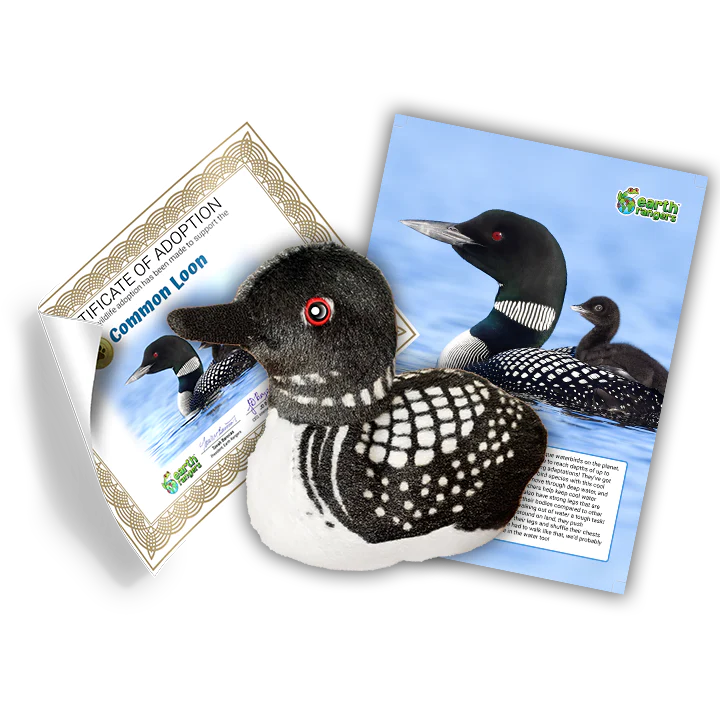
Today, Emma is taking a break from her whirlwind tour of National Parks in order to relax and have a fun night at the movies. Hey, she’s supposed to be on vacation after all. But something in the movies’ sound effects starts her on a little side quest to learn more about one of North Americas most famous wailers: The Common Loon.
This episode features an interview with Kylie Clatterbuck, one of the wildlife Heroes at International Bird Rescue.
A Surprising Superstar!

Almost everyone has heard a loon’s wail, but not all may know what they are! You might recognize a loon’s mournful cry in films. They often appear to create atmosphere, tension, or wilderness scenes, even in places where the real animal doesn’t exist – like space!

Emma described the common loon as ranging between a Mallard duck and a Canadian goose. It can in fact grow as big as 32 inches, with its wingspan going up to 54 inches, not far from a small goose!

The beautiful common loon isn’t the only one out there. There is a great deal of diversity among the loons. In Canada and the United States alone we can find five different species of loon: The Common Loon, Pacific Loon, Arctic Loon, Red-throated Loon, and Yellow-billed Loon.

Several of these loon species change color between summer and winter. During summer, you can recognize the common loon with its back and white spots, black head, and red eyes. In winter, they become plain gray. Some loons, like the Red-throated loon, will even lose their red patch during the winter.
A Loony Prize!
Aren’t loons awesome? I don’t know about you, Earth Rangers, but I’d love a cute loon plush hanging out with me (especially if I can enjoy listening to its call!). Well…Guess what? One of you can have just that! But who?
To find one out, let’s play a game: Share which trivia you liked the most after listening to the podcast, and you might be the one to win your very own common loon plush bundle, just like the one below.

How will we pick the winner? The winner will be picked completely at random from a raffle of the first 200 people to comment on their very own loon facts.
Remember – this is the question you need to answer:
“What is your favorite loon trivia from the episode?”
A Loon Expert

In this episode, Emma had the pleasure of talking with bird expert Kylie Clatterbuck, Manager of Bird Rescue’s Los Angeles Wildlife Center! Kylie has been a lead responder for oil spills and other wildlife emergencies, helping to save loons and many different birds across the word. She even traveled to save some flamingo chicks in South Africa!
Kylie and the others at the International Bird Rescue care for loons that are injured, oiled, sick, or suffering from starvation. They help them recover so they can be released back into the wild to live a happy life for years to come.
Thanks to Kylie, Emma learned some fun trivia about loons. But that is not all! There are plenty of other loon facts to dive into. Earth Rangers has plenty of fun Wildwires to check out, so why not give it a look?

What was your favorite loon fact from the episode? Do you have any other fun loon trivia?
Let us know in the comments below!
For more information about the Common Loon or to learn more about the International Bird Rescue’s mission, please visit their website at https://www.birdrescue.org/


I liked that you only see Loons on land when they are nesting. That’s my favorite fact !
Loons have solid bones, unlike most birds. This makes them less buoyant and better divers. They can also compress their feathers and force air from between the feathers from air sacs in the body, allowing them to quietly submerge in the water.
Their hip bones are arranged more to the back so steps on land are awkward. The spend most of their life on water.
I wood have wings
Unlike most birds loons have solid bones making them less boyunt but the still somehow flot. Amazing!
My favorite fact is that baby loons ride on their parents backs!
Loons can also sometimes dive to the depths of 60 meters (200 feet)! And my favorite fact was when they make nests
It lives in the northern hemisphere,mainly on northern lakes,and only goes on land to mate and incubate it’s eggs.It has a black-and-white checkered back, an iridescent black head and neck,a black bill,red eyes,and two white necklaces in it’s summer breeding plumage.It is a large bird,weighing between 6 to 14 pounds,and has an average wingspan of 41-52 inches.It has solid bones,and large muscles,which makes it a great swimmer and diver,but not very efficient at flying or walking on land. It feeds primarily on fish,which it catches and swallows while on underwater dives.It has a variety of eerie calls,which it uses to communicate with other loons and defend its territory.
Is that too much?
We liked that they eat bugs.